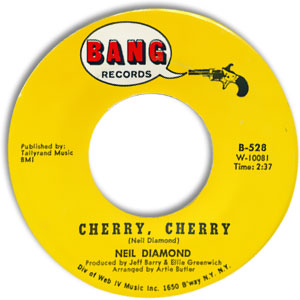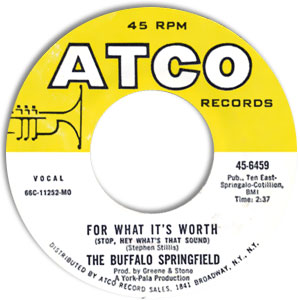
The Joy of 45 Collecting:
Sound Gallery Comparing 45s and LPs
Back to "The Joy of 45 Collecting: Why 45s?"
Other Galleries: Labels A-E, F-O, P-Z | Factory Sleeves | Picture Sleeves | Colored Vinyl | Promos
This page gives some examples of audio to help illustrate the differences in sound between 45s and LPs. The page is divided into three sections:
To listen to each example, just click on the blue "play" icon that follows each list item.
Loudness and Clarity
As described elsewhere in this "book", 45 rpm records have the potential to sound better than their 33 1/3 rpm counterparts. They can be mixed to higher line level than LPs, and they contain more "information" about each recording, since they spin faster and have longer grooves, which to most ears translates to better clarity and dynamic range of the captured sound. Examples abound, but I've chosen a handful to illustrate these two points: (1) 45s are "louder" and (2) they have cleaner audio (assuming they are mastered and pressed on decent vinyl or styrene).
Loudness.—As the page explaining why 45s sound better describes, 45s are by default pressed with louder audio than LPs. In fact, long LPs actually have to have their line level reduced to avoid groove skipping and audio bleed-through from one track to another. Here are some examples that illustrate this: These are recordings made before "normalizing" the audio to its loudest possible level without introducing distortion. (I've converted the LP versions to Mono mixes if necessary to be sure the comparison doesn't get "muddied" by listening to "Stereo vs. Mono".)
 |
"Big Yellow Taxi" by Joni Mitchell (1970, Reprise 0906) |
 |
"Rescue Me" by Fontella Bass (1965, Checker 1120) |
 |
"Green River" by Creedence Clearwater Revival (1969, Fantasy 625) |
 |
"I'm Ready For Love" by Martha & the Vandellas (1966, Gordy 7056) |
Clarity.—Because of the physical nature of 45s, the audio they contain is typically not only louder but also clearer, with better defined bass and treble (a symptom of improved dynamic range). To these ears, 45s are by nature brighter with better bass, and the quiet passages betray no tape hiss whatsoever. LPs typically sound a bit muddled by comparison, and "normalizing" LP audio to a higher line level can reveal previously unheard tape hiss.
 |
"That'll Be The Day" by Buddy Holly & The Crickets (1957, Brunswick 55009) Notice how much brighter the lead guitar sounds in the 45 version. The difference you hear is not accounted for a louder Mono mix, by the way. The 45 version simply has more high-end and a cleaner bottom: Overall a much cleaner, clearer sound. |
 |
"Happy Jack" by The Who (1967, Decca 32114) In addition to displaying wider dynamic range, the 45 sound avoids the LP version's problem when "normalized": It reveals a layer of audible tape hiss that's completely absent from the crisp, clear 45 version. Pay attention to the way the drums sound in the two versions, and you should notice how much brighter and defined they are in the 45 version. |
 |
"Baby I Love You" by Aretha Franklin (1967, Atlantic 2427) After listening to the LP version, the 45 version simply sounds brighter, making the LP version sound as if it's a bit under water. :-) You can hear the difference easily by listening to the drums in each version. |
 |
"I'm Ready For Love" by Martha & the Vandellas (1966, Gordy 7056) Again, listen to the LP version first, which doesn't sound bad! But then try the 45 version, and the difference is night and day, with a much wider dynamic range. Notice how much cleaner the instruments with a lot of high-end frequencies sound: The drums, the guitar, for example. |
 |
"Bernadette" by Four Tops (1967, Motown 1104) You might be tempted to think, after listening to both versions, that the 45 version is simply "louder." But it's not — it simply has a wider dynamic range, so you can hear music that's missing from the LP version: That's what makes it sound "louder" — its greater clarity. |
Stereo vs. Mono
This section provides audio files comparing LP Stereo mixes with the original Mono mix found by default on U.S. 45s until about 1972/73. Listening to these, try to remain open-minded about Mono mixes, since most listeners will be biased toward Stereo, the type of mix most often provided. Stereo was introduced in the late 1950s, but in general Stereo did not become standard for LPs until the mid-to-late 1960s. It took longer for Stereo to become standard on 45 rpm records, and even promo 45s in the 1970s provided both Stereo and Mono mixes by default. I have written more about the Stereo vs. Mono debate elsewhere in this book. The basic premise in my belief that Stereo wasn't really ready for prime time until about 1968-70, when better recording equipment became available. Until then, limited to only 8 channels, Stereo mixes tend to diffuse the sound by miking instruments and voices in isolated left/right channels rather than placing them front and center. Mono mixes were carefully constructed so as to layer on each instrument and voice, emphasizing some parts of the arrangement by bringing them forward in the mix and de-emphasizing others by pushing them further into the background. With early Stereo, the only way of "deemphasizing" a given instrument was to isolate it in one channel or the other, and the only way to achieve emphasis was to increase the volume and put the instrument or voice in the sonic "middle." This can lead to a lot of head-turning, depending on your Stereo setup, or can present the music as a collection of individual instruments rather than being heard as a consolidated whole. In all cases, the audio files have been "normalized" to facilitate clear comparisons.
 |
"Bus Stop" by The Hollies (1966, Imperial 66186) Notice how the Stereo version mikes the lead guitar and drums into the left channel and the lead vocal into the right. All of these key components of the arrangement should rightfully be given the appropriate place of power: The middle of the mix. |
|
 |
"Cherry, Cherry" by Neil Diamond (1966, Bang 528) In this case, the lead rhythm guitar is in the right channel, with the hand-claps in the left. The main vocal is miked in the center, but the backing vocals are consigned to the left channel. When the piano comes in, it's in the right channel. All of these components deserve their rightful place in the center of the sound and are simply diminished by assigning them to a single channel. |
|
 |
"Everyone's Gone To The Moon" by Jonathan King (1965, Parrot 9774) This Stereo mix sounds generally diffused, but notice in particular that the double-miked vocals appear segregated in the left and right channel, with no vocal in the middle of the mix. |
|
 |
"Where Did Our Love Go" by The Supremes (1964, Motown 1060) Here, the "walking feet" move from right to left before settling for good in the left channel. Meanwhile, the piano starts up in the right channel, which is also where the drums dominate. At least they put Diana Ross' lead vocal in the middle, but the overall effect is to scatter important musical elements to distinct channels, diminishing the recording's potential power, which is evident in the Mono mix. |
|
 |
"For What It's Worth" by Buffalo Springfield (1967, Atco 6459) This Stereo mix is a mess! The lead guitar opens in the left channel, while the rhythm guitar opens in the right. The drums are also consigned to the right channel, while Stephen Stills' lead vocals are in the left channel. Backing vocals show up in the right channel. All of these elements need to be in the center of the mix, which the Mono mix provides. |
|
 |
"Gentle On My Mind" by Glen Campbell (1967, Capitol 5939) For some reason, whoever concocted this Stereo mix decided that the lead guitar would be in the right channel and the bass guitar in the left. Fortunately, Campbell's vocals sit in the middle of the mix. |
|
 |
"Nowhere Man" by The Beatles (1966, Capitol 5587) In the Stereo version, the lead vocals are positioned toward the right channel while the stunning lead guitar takes its place in the left. The main drums are also miked toward the left channel. When the lead guitar goes for its solo, the engineers moved it to the right channel. Go figure! |
Alternate Takes
A few 45s over the years were released with completely different recordings than those on the artist's corresponding album. This section provides examples of three such 45s, comparing the 45 version with that on the LP. (All of these recordings have been "normalized" to ensure an apples to apples comparison.) You may prefer the version that appears on the LP, but that may be because it's the one you're used to. Regardless, keep in mind that it's the 45 version that was the "hit" when released, not the LP version. (To avoid possible distraction in the Mono vs. Stereo debate, all tracks below have been converted to the same mix type.) The 45 recordings are in danger of being lost, since they typically don't show up in compilations of the artists' music and therefore aren't available from music services like iTunes.
 |
"Help Me Rhonda" by The Beach Boys (1965, Capitol 5395) I don't think you'll need any help distinguishing between these two recordings. Among other differences, on the LP version the track begins with two guitars strumming out the riff, whereas the 45 version begins with the lead vocal and a single guitar. |
 |
"Country Road" by James Taylor (1971, Warner Bros. 7460) Among other differences here, listen to the opening lead acoustic guitar — a completely different pattern — and then notice the piano coming in the left channel. On the LP version, the piano contributes very little to the overall sound, whereas on the 45 it's a key, and appropriately loud, element. Taylor's vocals are also noticeably different. Later in the recording, the 45 version introduces a vocal chorus that's absent from the LP version. |
 |
"Rock Me On The Water" by Jackson Browne (1972, Asylum 11006) You should have no trouble distinguishing these two recordings, as they're quite different in a number of ways. First of all, the LP version starts with Browne's vocals accompanied by a solo piano. The 45 starts with an instrumental intro in which the piano is joined by bass, drums and guitar. Another major difference is that on the LP Browne makes you wait until after the second verse to hear the chorus, whereas the re-recorded 45 version gets right to the chorus after the first verse. |